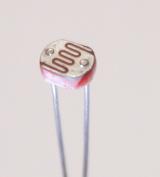Electronics notes/Light sensing
Photo-somethings
photocell, or photoconductive cell, photosensor, and photodetector [1] are more descriptions more than a specific implementation, though they tend to refer to one of the first three:
In comparison:
- photoresistor, a.k.a. light dependent resistor (LDR)
- Response: slowest - ~tens of milliseconds for rise, and noticeably slower for fall
- medium sensitivity
- easier to produce for certain frequencies (like IR)
- response curve more logarithmic (which can be useful for some purposes)
- regularly Cadmium sulfide (CdS) cell, cadmium Selenoum (CdSe) cell have a good response in the visible spectrum
- PbS, PbSe, InSb, and GeCu are mainly sensitive in near, mid, and far infrared
- note that cadmium and lead are not not RoHS compliant. shouldn't matter for DIY, may matter when building products.
- photodiode
- Response: fastest of the three - microseconds
- less sensitive than phototransistor (and photoresistor)
- response curve more linear (verify)
- (also note you can use LEDs as photodiodes, see below, though not a very good one)
- phototransistor
- Response: tens of microseconds. slower than photodiodes but fast enough for a lot of things
- higher sensitivity than photodiodes
Also:
- avalance photodiode (APD) [2] use a high reverse bias voltage to create an effect much like
- photomultiplier - a vacuum tube design, rarely seen now (the nearest semiconductor equivalent is the APD)
http://www.electronicshub.org/light-sensors/
Photoresistors

Photoresistors (a.k.a. Light Dependent Resistor, LDR) are passive semiconductors. It is photosensitive because it has a (large(verify)) n-p junction, that is intentionally exposed to the outside world.
Not to be confused with phototransistors or photodiodes
Historically best known for the CdS type, though it's now less used because the Cadmium in CdS (and CdSe) is considered toxic by RoHS so can't really be sold in Europe.
Resistance in the dark tends to be on the order of 0.1MΩ to 2MΩ,
In the light (e.g. 10 lux) resistance is usually somewhere in the range of a few kΩ to a few dozen kΩ.
The curve is nonlinear, rising faster at the light end.
Less sensitive than photodiodes and phototransistors.
Also slower than them - photoresistors may take
- e.g. 10-30ms dark to light
- 30ms to maybe a second from light to dark
See also:
Photodiode and phototransistor
Again, all PN junctions are light sensitive, so if exposed, you create a photosensitive thing.
(This is also why LEDs work as photodiodes, and can be used as crude light sensors. They are in essence the same device, it's just that LEDs have been optimized for emission and aren't as sensitive used as photodiodes. See e.g. [3])
Photodiodes seem to typically be typically Si-Ge (Silicon-Germanium).
Phototransistors react slower (below a few dozen kHz) but can be ~100 times more sensitive than photodiodes (because they have built in gain(verify)), but also easily 10x slower response (still microseconds, but it can matter)
Photodarlingtons are a variant of phototransistor with higher gain yet.
Phototransistors may not expose their Base, as it's not necessary.
It may still be there, letting you use it as a regular and phototransistor. (verify)
Sensitivity is in part about gain - which in a circuit you can always control, though in a single component phototransistors are better at,
which also makes it more about noise, because it becomes the question of "what sort of signal can I deal with cleanly".
Also the fact that photoresistors are nonlinear can make a big practical difference.
See also:
Optocouplers (a.k.a. photocoupler, opto-isolator) - since the point is electric isolation, they are typically inside the same IC, nothing optical you can do with it